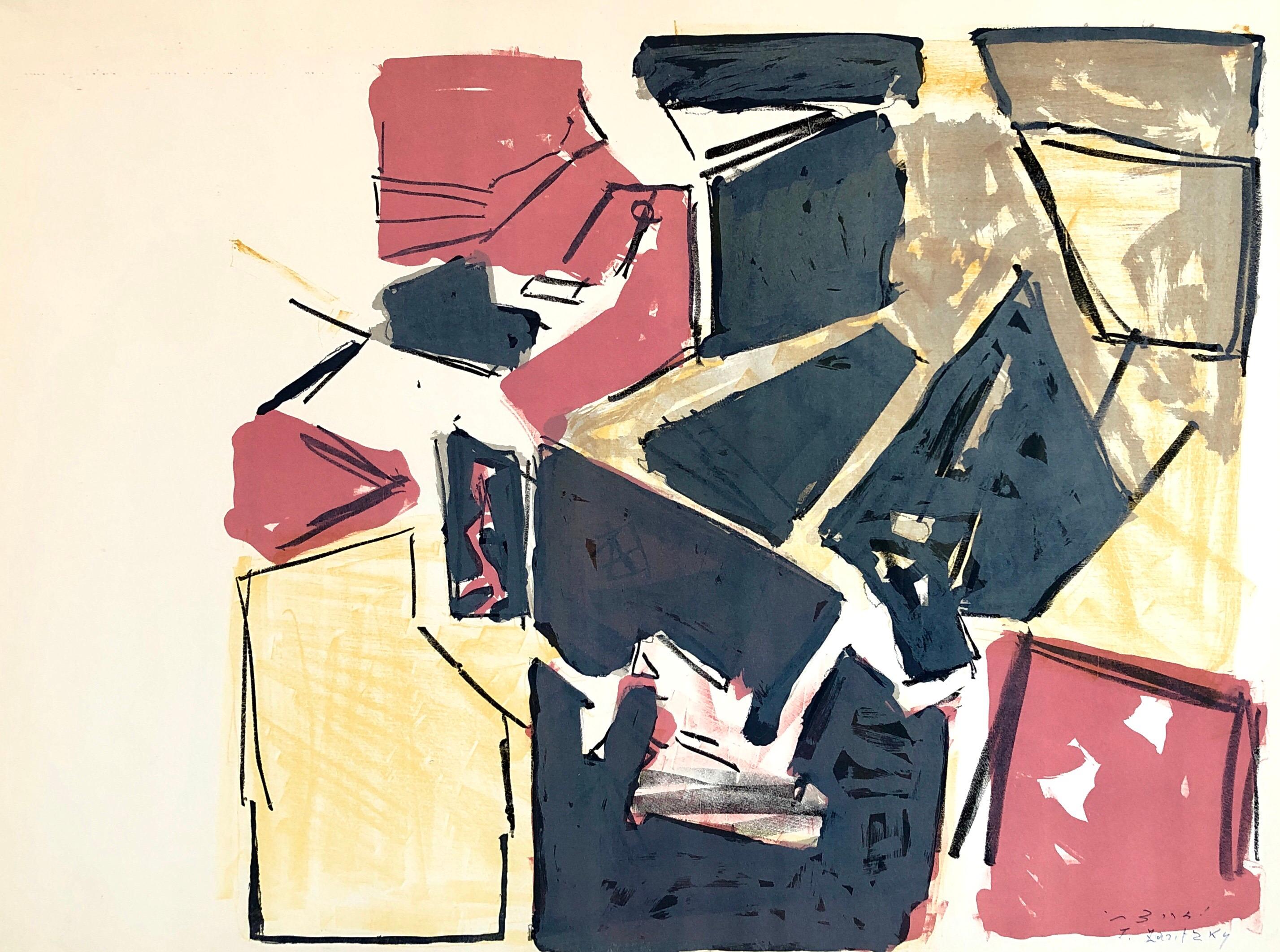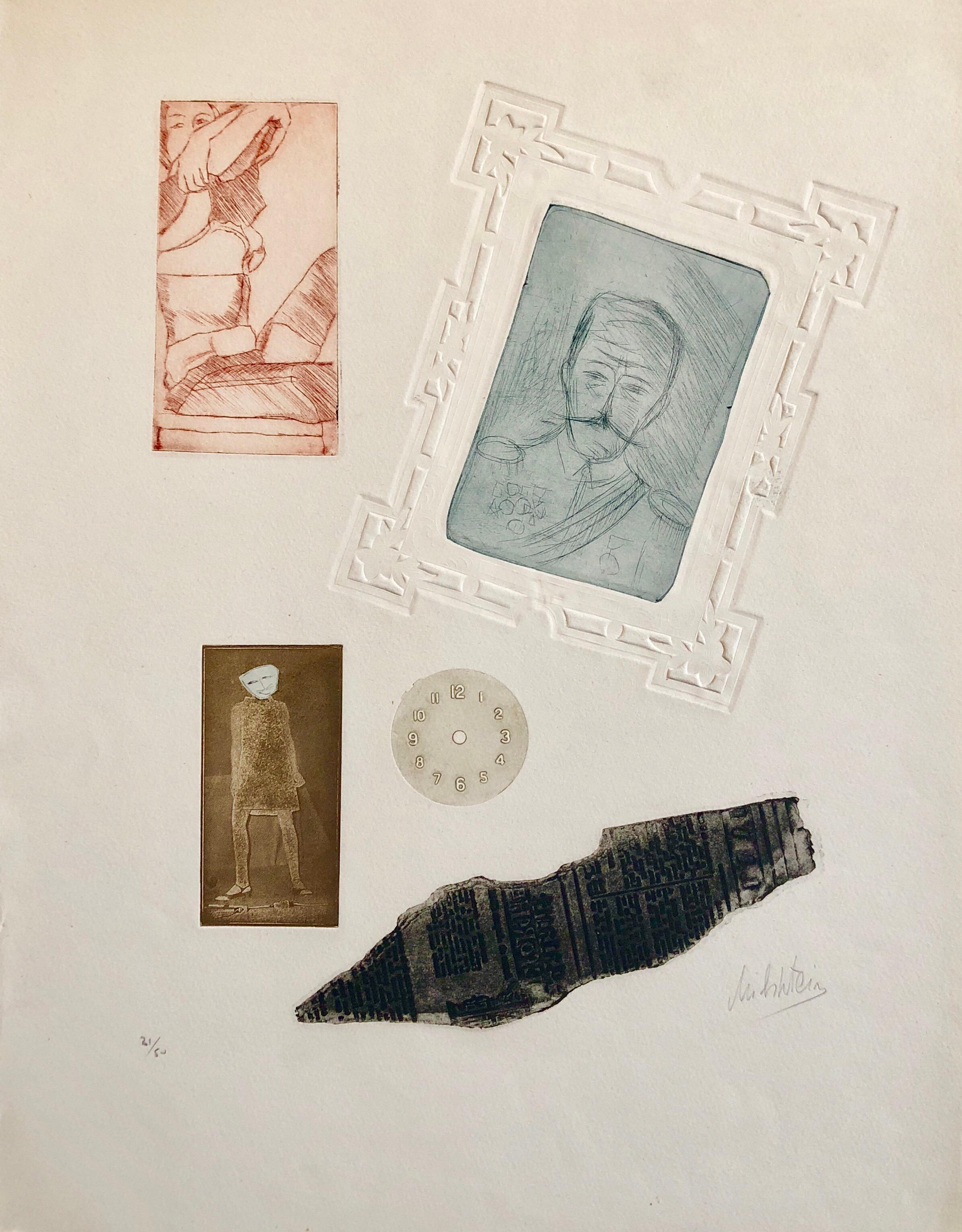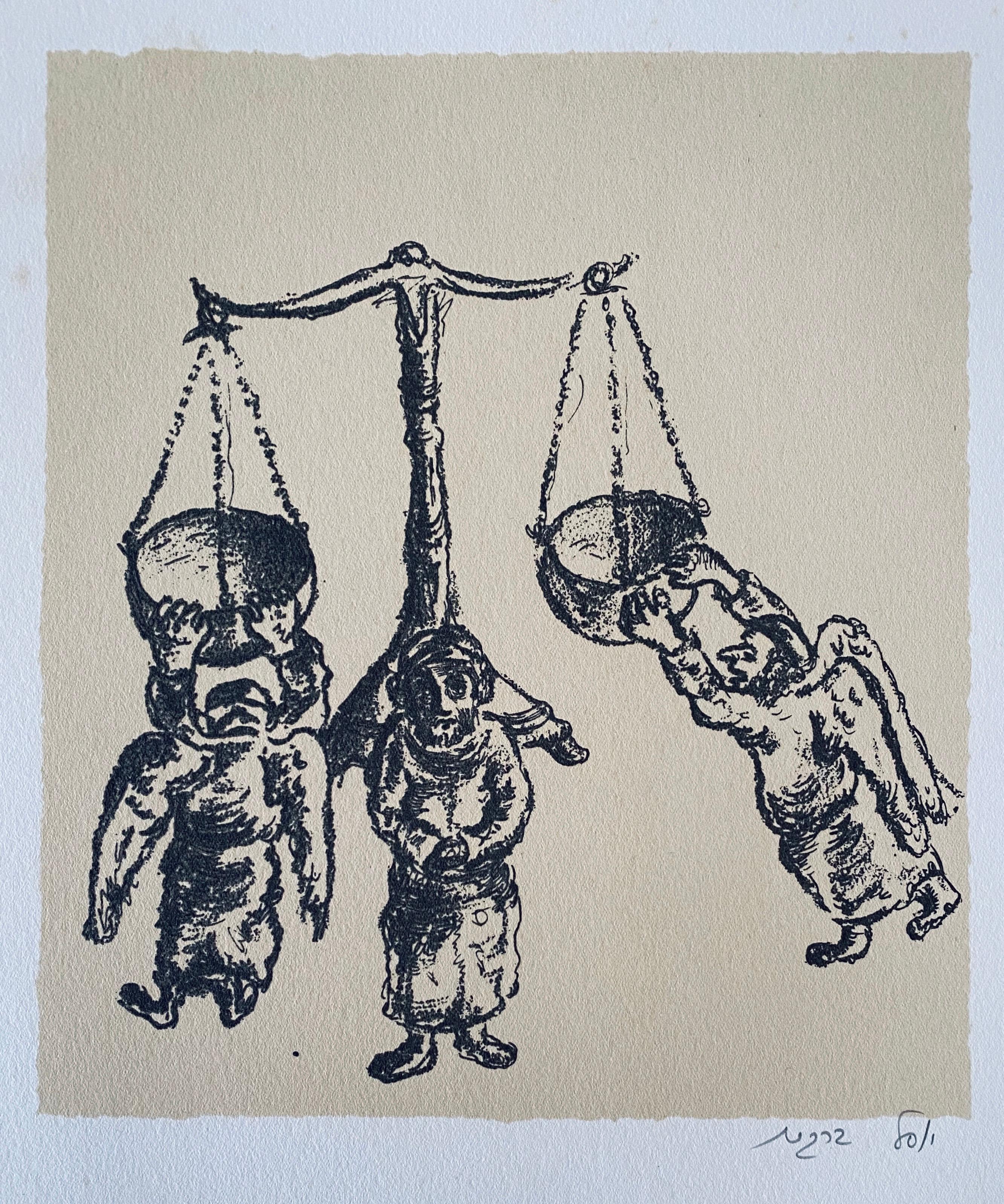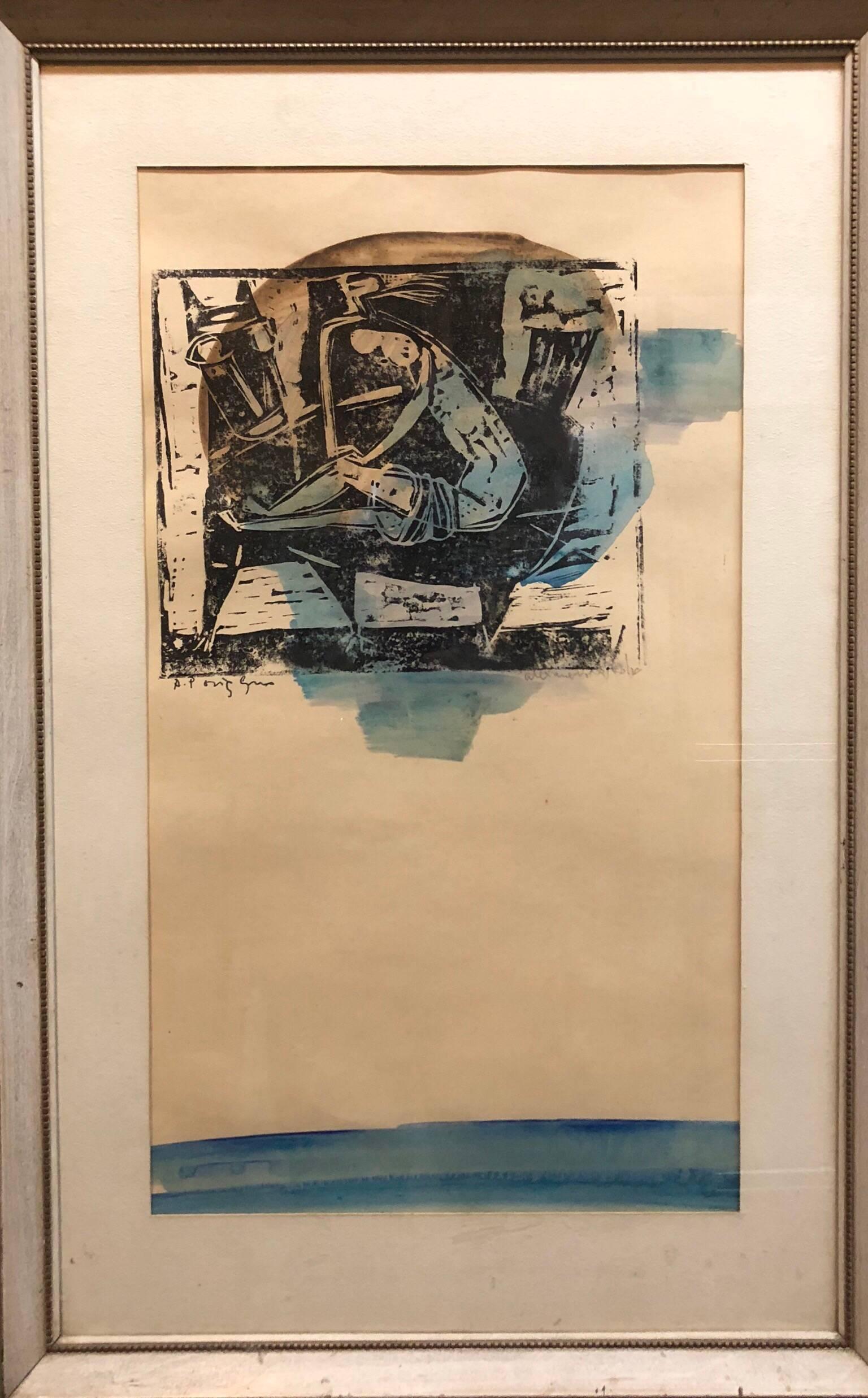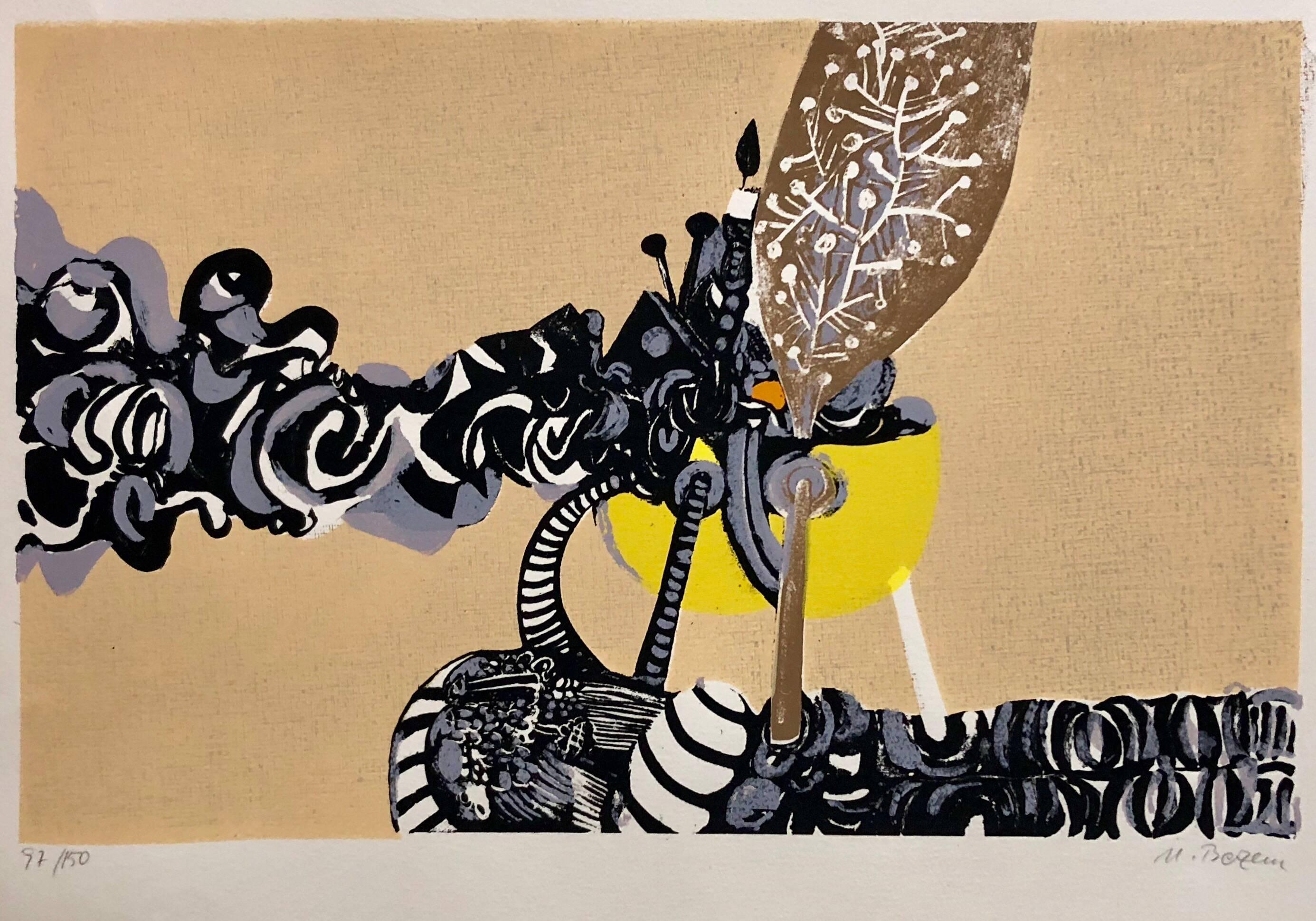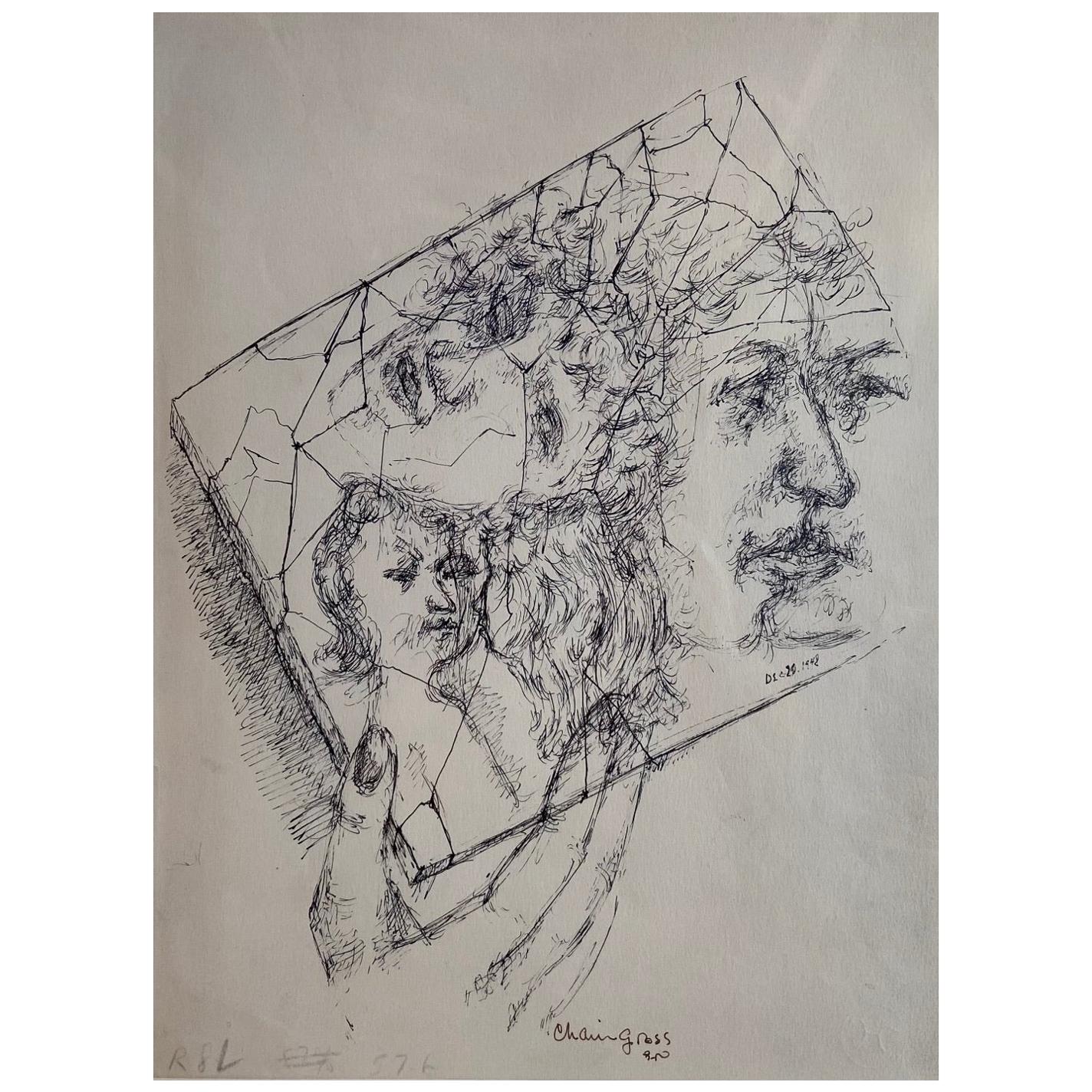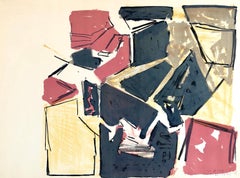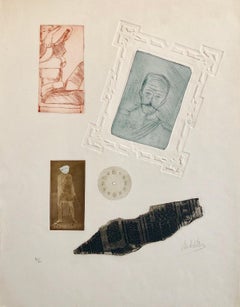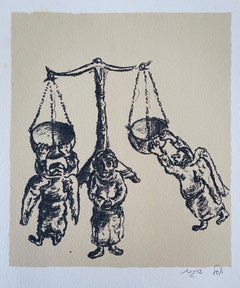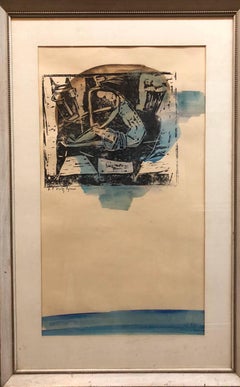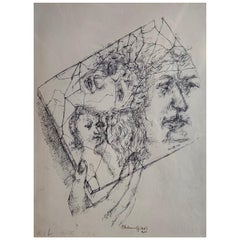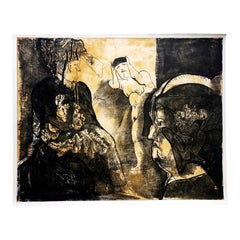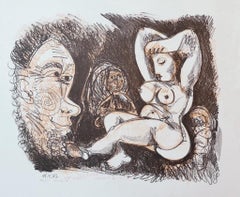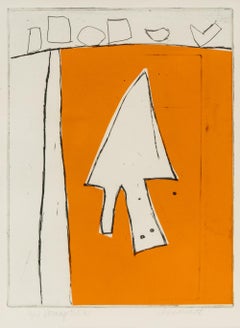Items Similar to Figural Abstract Mid Century Modern Lithograph Portraits, Judaica, Jewish Print
Want more images or videos?
Request additional images or videos from the seller
1 of 10
Rita GombinskiFigural Abstract Mid Century Modern Lithograph Portraits, Judaica, Jewish PrintMid 20th Century
Mid 20th Century
$400
£303.08
€347.76
CA$562.86
A$618.74
CHF 325.18
MX$7,513.79
NOK 4,056.58
SEK 3,843.32
DKK 2,595.39
About the Item
This is a proof print and is unsigned. it has Jewish Hebraic motifs, a menorah with a Jewish star, a mezusah or megilla scroll by this talented Jewish woman artist. Her whole life long, through the births of two children, the deaths of two husbands, three wars and across two continents, Rita Gombinksi has painted.
Her studio, now an apartment in the Irving Cypen Tower at the Miami Jewish Home and Hospital for the Aged, nearly brims with works -- in closets, leaning against walls and stacked in boxes. Some date to just months ago. Some are seven decades old. There is one large collage that was completed during the fall of Saigon. On a dresser is a portrait of a young Gombinski and her second husband as newlyweds, done in her intricate abstract style. Works in progress are spread across an old dining room table, now used as a kind of easel.
Rita Gombinski sits among some of her drawings that she is sorting through. Despite this breadth and consistency, it is with some bemusement that Gombinski, who turns 88 this month, takes in a renewed interest in her work.
"I'm trying to be organized," she says as she searches through one of dozens of albums containing small works and photographs of works sold. "Slowly but surely I'm going to put things together. It's not easy because I've done so much."
Gombinski, who owned the Gombinski Gallery with her husband, Mendel, at 900 Lincoln Rd. in Miami Beach, for a decade in the 1980s and 1990s, and two other galleries in New York and Israel, is now the artist-in-residence at the Miami Jewish Home, a title she announces sheepishly. "I donated so much of my art that I have been called the artist-in-residence here," she says of approximately 150 paintings she gave to the home.
She has also donated paintings to the Bass Museum, University of Miami and organizations in Israel, where she lived during the 1970s. Gombinski's work, done mostly in watercolor but also crayon and ink, evolved from her most influential teacher, William Baziotes, an abstract expressionist and surrealist whose works are in the Guggenheim collection. Perhaps more influential, she said, were the patterns from her family's textile company. Quite often she starts by painting a pattern, then inserts a figure.
Gombinski grew up in the Bronx and can still vividly recall her first recognized work: a painting of a cat done in elementary school. In her senior year in high school, she jokes, she received her first official critique after sending an article and illustration from the high school paper to famed New Yorker critic Alexander Woollcott, whose yellowing note card she keeps in a journal:
An abstract painting by Rita Gombinski depicts the artist and her second husband. "I think you have considerable promise -- even if you don't yet know the difference between infer and imply," he wrote, referring to her misuse of the words.
She went on to marry her high school sweetheart, a textile engineer, and in about 1943 moved to South Carolina. He joined the Air Force to avoid being drafted into the army and they moved to Sarasota. But within months he was killed in a training flight. At the time, Gombinski was three months pregnant with her daughter.
Back in New York, living in a veterans' project for widows, she continued painting and raised her daughter. When her father's second cousin came to America after surviving a Russian concentration camp, she decided to remarry.
"After four years, I was ready for another life," she said. A year later, her son was born and in 1952, she received her bachelor's degree in fine arts from the Pratt Institute. She later earned a master's in art education from New York University.
The new family opened their first gallery near Soho. But when Gombinski's father died, they moved to Florida. After several years, she and Mendel moved the family to Haifa, Israel, where they opened a second gallery. When Steven graduated from high school, they returned to Florida and opened their Lincoln Road gallery, which featured not only Rita's work, but works from Israelis and other young artists.
In the 1990s, when Mendel came down with Alzheimer's, Gombinski struggled to maintain the gallery, but found caring for her husband overwhelming. In 1996, he was moved to the Miami Jewish Home. Two years after he died, in 2001, Gombinski moved into the home's independent living building.
While she apologizes repeatedly for the clutter of art, she concedes that it is this art, and the selling and managing of it that has kept her going.
"If it wasn't for all this," she said, "I would have gone bananas."
- Creator:Rita Gombinski (1919 - 2015, American)
- Creation Year:Mid 20th Century
- Dimensions:Height: 20 in (50.8 cm)Width: 28 in (71.12 cm)
- Medium:
- Movement & Style:
- Period:
- Condition:
- Gallery Location:Surfside, FL
- Reference Number:Seller: 24451stDibs: LU38214224832
About the Seller
4.9
Platinum Seller
Premium sellers with a 4.7+ rating and 24-hour response times
Established in 1995
1stDibs seller since 2014
1,810 sales on 1stDibs
Typical response time: 1 hour
- ShippingRetrieving quote...Shipping from: Surfside, FL
- Return Policy
Authenticity Guarantee
In the unlikely event there’s an issue with an item’s authenticity, contact us within 1 year for a full refund. DetailsMoney-Back Guarantee
If your item is not as described, is damaged in transit, or does not arrive, contact us within 7 days for a full refund. Details24-Hour Cancellation
You have a 24-hour grace period in which to reconsider your purchase, with no questions asked.Vetted Professional Sellers
Our world-class sellers must adhere to strict standards for service and quality, maintaining the integrity of our listings.Price-Match Guarantee
If you find that a seller listed the same item for a lower price elsewhere, we’ll match it.Trusted Global Delivery
Our best-in-class carrier network provides specialized shipping options worldwide, including custom delivery.More From This Seller
View AllIsraeli Josef Zaritsky Abstract Modernist Lithograph Print "Composition"
Located in Surfside, FL
Abstract Composition, 1959 Lithograph
This was from a portfolio which included works by Yosl Bergner, Menashe Kadishman, Yosef Zaritsky, Aharon Kahana, Moshe Tamir and Michael Gross.
Joseph (Yossef) Zaritsky (Hebrew: יוסף זריצקי; September 1, 1891 – November 30, 1985) was one of Israel's greatest artists and one of the early promoters of modern art in the Land of Israel both during the period of the Yishuv (Palestine, the body of Jewish residents in the Land of Israel before the establishment of the State of Israel) and after the establishment of the State. In 1948 Zaritsky was one of the founders of the "Ofakim Hadashim" group. In his works he created a uniquely Israeli style of abstract art, which he sought to promote by means of the group. For this work he was awarded the Israel Prize for painting in 1959.
Joseph Zaritsky...
Category
1950s Modern Abstract Prints
Materials
Lithograph
Portraits Erotic Vignettes French Israeli Surrealist Aquatint Etching Le Colonel
By Zvi Milshtein
Located in Surfside, FL
Etching and Aquatint with embossing featuring a clock, the colonel, a nude woman undressing and a figure. This is numbered by hand in pencil and signed in pencil.
Zwy Milshtein (Zvi ...
Category
20th Century Expressionist Portrait Prints
Materials
Etching, Aquatint
Israeli Expressionist Yosl Bergner Modernist Lithograph
By Yosl Bergner
Located in Surfside, FL
Hand signed in Hebrew Lower right. Dimensions: H 19.5" x 13.5"
Bergner, Yosl (Vladimir Jossif) (b Vienna, 13 Oct 1920). surrealist, surrealism. belongs to the generation of people...
Category
Mid-20th Century Modern Figurative Prints
Materials
Lithograph
Abstract with Figures Israeli Mid Century Modernist Woodcut Watercolor Painting
By Stefan Alexander
Located in Surfside, FL
An abstracted composition containing a kneeling figure . this is a stamped print, woodcblock most likely artfully combined with moody watercolor.
Stefan Alexander, born Czechoslovak...
Category
Mid-20th Century Abstract Drawings and Watercolors
Materials
Watercolor, Woodcut
Rare Israeli Surrealist Judaica Abstract Lithograph Naftali Bezem
By Naftali Bezem
Located in Surfside, FL
Fine lithograph on deckle edged French Arches paper. Pencil signed and numbered from edition of 150.
A Surrealist Judaica scene of a bearded man (Rabbi) in a boat with Shabbat candlesticks. with blindstamp from Editions Empreinte in Paris, France. (They published, Jean Michel Folon, Sempe, Raoul Ubac, Raymond Savignac, Cesar, Bengt Lindstrom , Paul Aizpiri and many other modern masters.
Naftali Bezem (Hebrew: נפתלי בזם; born November 27, 1924) is an Israeli painter, muralist, and sculptor.
Bezem was born in Essen, Germany, in 1924. His early adolescence was spent under Nazi oppression, in constant fear for the safety of his parents, who perished in the Holocaust in the Polish Auschwitz concentration camp. Naftali emigrated to Mandate Palestine in 1939, at the age of fourteen with a Youth Aliyah group.
From 1943 to 1946, he studied art at the Bezalel Academy of Art and Design in Jerusalem with Israeli painter Mordecai Ardon. He then spent three years studying in Paris.His most famous public works include a wall relief at Yad Vashem in Jerusalem and the ceiling mural in the main reception room at the President's Residence, Jerusalem.In 1957, Bezem was a co-recipient of the Dizengoff Prize for Painting.
Group Exhibitions
Orit Art Gallery, Tel Aviv
Artists: Yosef Zaritsky, Marcel Janco, Lea Nikel, Robert Baser, Bezem, Michael Druks,
Israeli Painting (Watercolors and Gouache)
Artists:
Pinchas Abramovich, Bezem, Naftali Nachum Gutman, Haim Gliksberg, Mordechai Levanon, Avigdor Stematsky, Avshalom Okashi, Yehiel Krize...
Category
20th Century Modern Figurative Prints
Materials
Lithograph
1959 Israeli Aharon Kahana Modernist Aquatint Etching Judaica Rabbi & Students
Located in Surfside, FL
Abstract color composition, 1959 aquatint lithograph "the Master and his Pupils".
This was from a portfolio which included works by Yosl Bergner, Menashe Kadishman, Yosef Zaritsky, Aharon Kahana, Jacob...
Category
1950s Modern Figurative Prints
Materials
Aquatint
You May Also Like
Chaim Gross, Engraving, Composition Avec Visages, 1942
By Chaim Gross
Located in Saint ouen, FR
Chaim gross, engraving, composition avec visages, 1942
Signed by the artist
Measures: 30 x 22.5 cm.
Category
Vintage 1940s Central American Modern Prints
Materials
Paper
José Luis Cuevas Signed Limited Ed. Mexican Lithograph Lo Feo de Este Mundo III
By José Luis Cuevas
Located in Studio City, CA
A fantastic and oddly alluring large lithograph in colors on wove paper is by renowned Mexican artist José Luis Cuevas (1934-2017). It is titled "Lo Feo de Este Mundo III" and is fr...
Category
Vintage 1960s Mexican Mid-Century Modern Prints
Materials
Paper
Homage to Picasso - Lithograph by Gian Paolo Berto - 1974
Located in Roma, IT
Homage to Picasso is an original lithograph realized by Gian Paolo Berto, in 1974.
Good conditions.
Hand-signed in pencil on the lower left, dated, and numbered edition 20/25.
The...
Category
1970s Cubist Figurative Prints
Materials
Lithograph
Homage to E.W. (Emerson Woelffer), Original Mid Century Modern Lithograph
Located in Denver, CO
Discover a stunning vintage original lithograph by renowned Colorado Springs artist Mary Chenoweth. This striking abstract composition features bold geometric shapes set against a vi...
Category
Mid-20th Century Abstract Abstract Prints
Materials
Lithograph
"Papeles de Salazar" Modern Figurative Surrealist Abstract Lithograph Ed. 95/100
By José Luis Cuevas
Located in Houston, TX
Modern figurative surrealist lithograph by Mexican artist José Luis Cuevas. The work features two central seated figures with papers laid out on a table in front of them. The title r...
Category
1980s Abstract Figurative Prints
Materials
Lithograph
Raquel Forner (1902–1988) modernist print signed and numbered, untitled, 1958
Located in Farmingdale, NJ
Raquel Forner (1902–1988) was an Argentine painter known for her expressionist works.
A signed and numbered print, dated 1958, signed in pencil under the printed signature. ( likely...
Category
Vintage 1950s Mid-Century Modern Prints
Materials
Paper
More Ways To Browse
Jewish Star
Vintage Stacking Boxes
Jewish Menorah
Les Saltimbanques
Malcolm Morris
Marc Chagall La Place De La Concorde
Marc Daniel
Marquis De Sade Dali
Martin Katz
Matisse Signed Lithograph
Ming Wai
Moulin Rouge La Goulue
Orientalist Lithograph
Pablo Picasso Ballet Dancer
Pablo Picasso Couple
Pablo Picasso Minotaur
Paul Mann
Peter Arno
